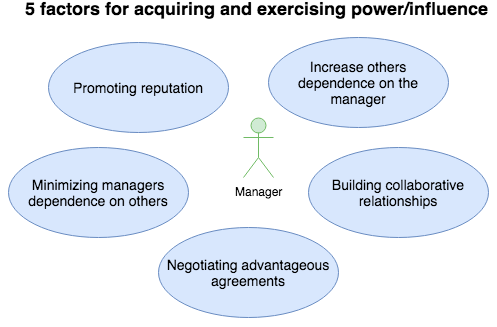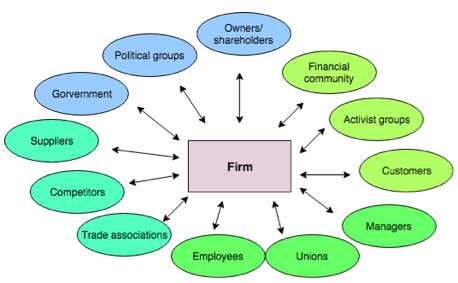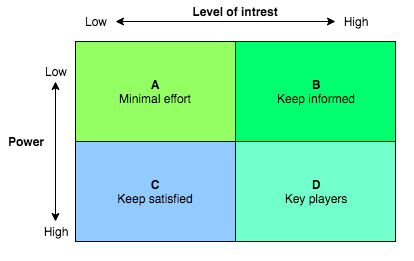Power, politics and stakeholder management
Contents |
Abstract
When managing any kind of project, programme or portfolio, different issues can occur that have an either positive or negative affect on the total outcome. These issues can be many different internal or external factors, as for example: the economy, natural incidents, people with specific agendas etc. An area of great importance with regard to these issues is stakeholder management, and how to navigate and handle different people, groups and organisations with relation to the project. “The ability of the project manager to correctly identify and manage these stakeholders in an appropriate manner can mean the difference between success and failure”.[1] Additionally managers will have to consider different key areas related to stakeholder management if this should be a success. The internal politics within organisations and the power and influence of stakeholders is crucial and should be considered with attention to specific factors.[2]
In this article stakeholders in relation to power and politics of different kind will be analysed and the classic stakeholder-mapping tool is presented as well as an assessment of power/influence in management.
The article comprises the following:
1. A description of when the stakeholder mapping is used and in the context it is applicable. Furthermore an explanation of how to acquire and exercising power/influence for management.
2. An applications guide of how to perform the stakeholder mapping.
3. A consideration of limitations within this topic.
Big idea
Managers need to be able to identify stakeholders that can effect the outcome of a given project or process. This has to be done, to correctly assess and determine how the manager should handle the positive or negative attitudes with regards to the project. Moreover managers need to comprehend and deal with the politics of different organisations and understand that “Companies and other institutions are becoming more complex and pluralistic”.[3] According to John Hayes many organisations “can be conceptualized as a collection of constituencies, each pursuing their own objectives”. It is to be considered that John Hayes looks at organisations as political arenas where individuals and groups will try to obtain their self-orientated goals by affecting others. This political standpoint presented by Hayes will claim that when detecting greater issues and conflict of interest, the power and influence of different people or groups will decide how the issue is resolved. The standpoint concludes that no rational and logic argument will be the deciding factor, and therefore power and influence cannot be ignored by any sensible manager.
After concluding this an explanation of John Hayes theory “5 factors for acquiring and exercising power/influence” will be described to display how a manager can use these factors in a favourable manner when handling stakeholders.
Managers and leaders can intensify their ability to influence others and gain power by promoting the five factors shown above. Based on a study made by John Hayes in collaboration with product development engineers from different larger mechanical productions companies it was determined that “politically competent managers were those who paid attention to these factors” [4] with the aim of making successful deliveries.
Promoting reputation
The first factor is promoting the reputation of the manager. Stakeholders will be more likely to accept and follow a manager when he/she is perceived to be competent and deliver the desired benefits. This means the manager not only need the right competencies but also need to be seen as a competent manager. As people, according to Hayes, will pay more attention to managers whom they perceive as competent, motivated and have the ability to affect outcomes.
Increase others dependence on the manager
The next factor is in regards to the managers’ ability of influencing the targeted stakeholders by increasing their dependence on him/her. A manager can assess ‘others’ dependence by:
• Understanding what the stakeholders seek from the manager, ex. information, resources contacts etc.
• Consider how these recourses are important to the stakeholders.
• Investigate how easily the stakeholders can obtain the resources from others.
The bullets above will give some understanding of how dependent others are of the manager. But in order to practise power it is also important that the stakeholders are aware of their dependency and the manager should make this clear more ore less discrete.
Minimizing managers dependence on others
After looking at the dependences stakeholders have on the manager, it is also important to consider own dependencies to others and minimize these as much as possible. Therefore the manager needs to identify to whom they have these dependencies and how to change the current situation. This can be done by looking at the following:
• Identify alternative sources of the given assets the manager requires
• Test existing agreements both internal and external where the manager sees stakeholders exercising power, because of current dependency relationships.
Building collaborative relationships
The fourth factor examines the relationships between managers and those they are dependent on. Building collaborative relationships within this area should improve the manager’s ability to influence other stakeholders, as the relationships should support the agenda from the manager. The bullets below are essential for achieving this:
• Close relationships gives the manager the opportunity to identify resources and information that others may need, but currently does not have. Hereby creating new possible dependencies in favour of the manager.
• Projects can have problems with limited recourses, not because they need more but the problem lies with those handling the resources, not knowing they are needed. Communication improvements facilitated by the manager should solve the problem.
• Improved relationships can also give a possibility of others using the new collaborative networks to impact third parties that elsewise would be unreachable for the management.
Negotiating advantageous agreements
The last factor revolves the issue of creating agreements that are of great advantaged for the project or company. It is stated by Hayes that most agreements are more or less based on a level of interdependence. Managers who are good at exercising power/influence on stakeholders should be aware of this statement by Hayes and realistically determine what the project or company can do for the stakeholder and visa versa. This should enable the manager to negotiate favourable working agreements that will support the project.
When handling stakeholders it was concluded that the five factors presented above is of great importance. Now a guide for how to identify and manage stakeholders will be presented as an assessment tool to understand if and where the manager should exercise power/influence.
Application
As stated in the previous section stakeholders or constituents are prone to behave in specific ways that can strengthen their power and ability to make desired outcomes happen. Therefore managers have to be alert with regard to this and identify important stakeholders, categorise them and analyse how to influence them, in order to achieve the desired success for the project.
As a tool for this managing process, the stakeholder map can be used. A guide for how to use the tool will be presented below:
When performing a stakeholder analysis it is important to look at it as a systematically process. Here the manager has to gather and analyse both quantitative and qualitative data and information with regards to those who should be considered having an impact throughout the project. This analysis should identify the interests, expectations and influence of different stakeholders and try to determine how they relate to the project. Furthermore an identification of stakeholder relationships could be developed and used to determine a power/influence strategy as described in the ‘Big idea’ section.
1. The first step of the analysis is identification of the different stakeholders. This step is sometimes referred to as the ‘Stakeholder brainstorm’ and involves a process where all who is possibly affected or/and could affect the outcome of the project is identified. This identification process is done by using the previous mentioned data and information. To make sure that all relevant stakeholders have been taken into account in this first step, interviews with already identified stakeholders can be an option to ‘search the market’.
Above is an illustration of different stakeholders in a large organisation.[5] This show how the different groups, people or companies affect the firm leading the project, but on the other hand can also be affected by the project as mentioned in step 1. All these different stakeholders can be a big challenge, especially if the organisation handling the project is large, because many different groups will have conflicting interests and expectations. With this issue taken into account managers will have to analyse the power of the stakeholders.
2. The second stage of the analysis comprises of an assessment of impact or support from each of the different stakeholders. This assessment should be done by classifying all the identified parties with regards to how much power and influence they have on the specific project. This classification should be done by using the power/interest grid in which the manager will categorise the stakeholders “based on their level of authority (power) and their level of concern (interest) regarding the project outcomes” [6] and place them in the matrix as seen below.
Though it might seem fairly easy to do the categorisation of the stakeholders, difficulties in this process can occur.[7]
Two factors are of great importance when considering these difficulties:
• Individuals or organisations with known support of the project cannot be trusted because other groups or people within their organisation undermine their support.
• The second factor is with regards to assessing stakeholders with great power. There may be people or groups with a considerably big power connected to the project, but who has not exercised it in the past. This can be a risk if the stakeholder has drastically more power than expected or lately acquired the power to influence others but is handled inadequately by the manager.[8]
Limitations
Yes many limitations is to be considered in this article - this will be a research for the next coming days ;-)
Annotated bibliography
[1] The book gives an overview of how to identify, and plan for management of stakeholders, as well as manage and control engagement with stakeholders in relation to project management.
References
- ↑ Project Management Institute, A Guide to the Project Management Body of Knowledge (PMBOK® Guide), Fifth Edition, 2013
- ↑ Hayes J. The Theory And Practice Of Change Management, Fourth Edition, 2014
- ↑ Hayes J. The Theory And Practice Of Change Management, Fourth Edition, 2014
- ↑ Hayes J. The Theory And Practice Of Change Management, Fourth Edition, 2014
- ↑ Johnson G.,Whittington R., Scholes K., Angwin D., Regnér P. Fundamentals Of Strategy, Third Edition, 2015
- ↑ Project Management Institute, A Guide to the Project Management Body of Knowledge (PMBOK® Guide), Fifth Edition, 2013
- ↑ Hayes J. The Theory And Practice Of Change Management, Fourth Edition, 2014
- ↑ Hayes J. The Theory And Practice Of Change Management, Fourth Edition, 2014


